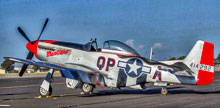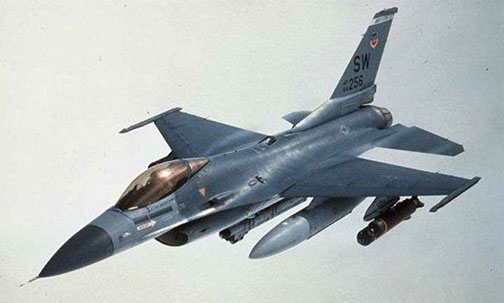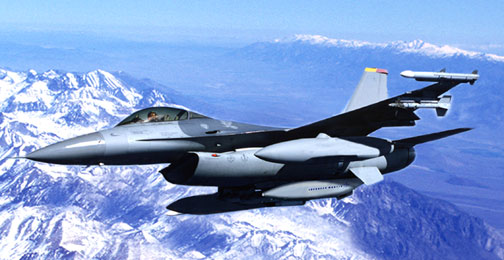The F-16 Fighting Falcon

The F-16 Fighting Falcon is a compact, multirole fighter aircraft. It is highly maneuverable and has proven itself in air-to-air combat and air-to-surface attack. It provides a relatively low-cost, high-performance weapon system for the air forces of the United States and allied nations.
Features
In an air combat role, the F-16’s maneuverability and combat radius (distance it can fly to enter air combat, stay, fight and return) exceed that of all potential threat fighter aircraft. It can locate targets in all weather conditions and detect low flying aircraft in radar ground clutter.
In an air-to-surface role, the F-16 can fly more than 500 miles (860 kilometers), deliver its weapons with superior accuracy, defend itself against enemy aircraft, and return to its starting point. An all-weather capability allows it to accurately deliver ordnance during non-visual bombing conditions.
In designing the F-16, advanced aerospace science and proven reliable systems from other aircraft such as the F-15 and F-111 were selected. These were combined to simplify the airplane and reduce its size, purchase price, maintenance costs and weight. The light weight of the fuselage is achieved without reducing its strength. The F-16 can withstand up to nine G’s — nine times the force of gravity — with internal fuel tanks filled greater than any other current fighter aircraft.
The cockpit and its bubble canopy give the pilot unobstructed forward and upward vision, and greatly improved vision over the side and to the rear. The seat-back angle was expanded from the usual 13 degrees to 30 degrees, increasing pilot comfort and gravity force tolerance.
The pilot has excellent flight control of the F-16 through its “fly-by-wire” system. Electrical wires relay commands, replacing the usual cables and linkage controls. For easy and accurate control of the aircraft during high G-force combat maneuvers, a side stick controller is used instead of the conventional center-mounted stick. Hand pressure on the side stick controller sends electrical signals to actuators of flight control surfaces such as ailerons and rudder.
Avionics systems include a highly accurate inertial navigation system in which a computer provides steering information to the pilot. The plane has UHF and VHF radios plus an instrument landing system. It also has a warning system and modular countermeasure pods to be used against airborne or surface electronic threats. The fuselage has space for additional avionics systems.
Background
The F-16A, a single-seat model, first flew in December 1976. The first operational F-16A was delivered in January 1979 to the 388th Tactical Fighter Wing at Hill Air Force Base, Utah.
The F-16B, a two-seat model, has tandem cockpits that are about the same size as the one in the A model. Its bubble canopy extends to cover the second cockpit. To make room for the second cockpit, the forward fuselage fuel tank and avionics growth space were reduced. During training, the forward cockpit is used by a student pilot with an instructor pilot in the rear cockpit.
All F-16s delivered since November 1981 have built-in structural and wiring provisions and systems architecture that permit expansion of the multirole flexibility to perform precision strike, night attack and beyond-visual-range interception missions. This improvement program led to the F-16C and F-16D aircraft, which are the single- and two-place counterparts to the F-16A/B, and incorporate the latest cockpit control and display technology.
Currently, most active units have converted to the F-16C/D while existing F-16A/B aircraft will replace older aircraft in the Air National Guard and Air Force Reserve.
The F-16 is being built under an unusual agreement creating a consortium between the United States and four NATO countries: Belgium, Denmark, the Netherlands and Norway. These countries jointly produced with the United States an initial 348 F-16s for their air forces. Final airframe assembly lines were located in Belgium and the Netherlands. The consortium’s F-16s are assembled from components manufactured in all five countries. Belgium also provides final assembly of the F100 engine used in the European F-16s.
The long-term benefits of this program will be technology transfer among the nations producing the F-16, and a common-use aircraft for NATO nations. Through this program the supply and availability of repair parts in Europe is increased and improves the F-16’s combat readiness.
USAF F-16 multi-mission fighters were deployed to the Persian Gulf in 1991 in support of Operation Desert Storm, where more sorties were flown than with any other aircraft. These fighters were used to attack airfields, military production facilities, Scud missiles sites and a variety of other targets.









































